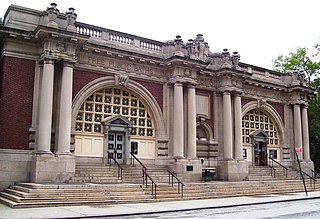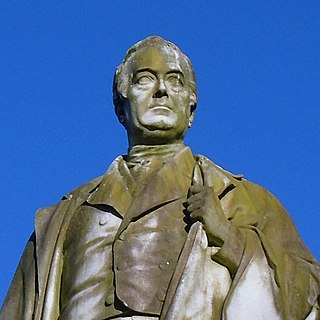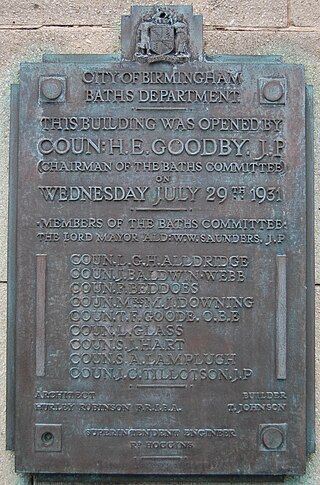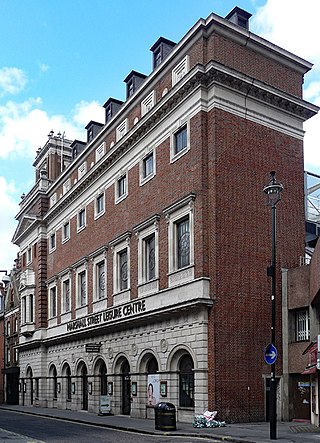
A bathroom, restroom or washroom is a room, typically in a home or other residential building, that contains either a bathtub or a shower. The inclusion of a wash basin is common. In parts of the world e.g. India, a toilet is typically included in the bathroom; in others, the toilet is typically given a dedicated room separate from the one allocated for personal hygiene activities. In the United States, the word 'bathroom' is often used to refer to any room that contains a toilet, regardless of the inclusion of a bath or shower.

Sir George Grey, 2nd Baronet, PC was a British Whig politician and a scion of the noble House of Grey. He held office under four Prime Ministers, Lord Melbourne, Lord John Russell, Lord Aberdeen, and Lord Palmerston, notably serving three times as Home Secretary for a collective 13 years.

Bathing is the act of washing the body, usually with water, or the immersion of the body in water. It may be practiced for personal hygiene, religious ritual or therapeutic purposes. By analogy, especially as a recreational activity, the term is also applied to sun bathing and sea bathing.

Public baths originated when most people in population centers did not have access to private bathing facilities. Though termed "public", they have often been restricted according to gender, religious affiliation, personal membership, and other criteria.

A spa is a location where mineral-rich spring water is used to give medicinal baths. Spa towns or spa resorts typically offer various health treatments, which are also known as balneotherapy. The belief in the curative powers of mineral waters goes back to prehistoric times. Such practices have been popular worldwide, but are especially widespread in Europe and Japan. Day spas and medspas are also quite popular, and offer various personal care treatments.

Manchester Royal Infirmary (MRI) is a large NHS teaching hospital in Chorlton-on-Medlock, Manchester, England. Founded by Charles White in 1752 as part of the voluntary hospital movement of the 18th century, it is now a major regional and national medical centre. It is the largest hospital within Manchester University NHS Foundation Trust, and based on its Oxford Road Campus in South Manchester where it shares a site with the Royal Manchester Children's Hospital, Manchester Royal Eye Hospital and Saint Mary's Hospital as well as several other educational and research facilities. The Hospital is also a key site for medical educational within Manchester, serving as a main teaching hospital for School of Medical Sciences, University of Manchester.
Events from the year 1832 in the United Kingdom.

Poplar Baths on the East India Dock Road in Poplar, London is a former public bath house and Grade II listed building that was constructed in 1933 and closed to the public in 1988. The Baths are adjacent to All Saints DLR station. A campaign to restore the baths won the support of Tower Hamlets Council in 2010 and the construction company Guildmore was appointed to complete the works to create a new leisure centre incorporating a swimming pool, gymnasium and affordable housing on adjacent land. The site reopened in July 2016.

William Rathbone V was an English merchant and politician, serving as Lord Mayor of Liverpool.

The Public Library and Baths on Moseley Road, Balsall Heath, form one of many pairings of baths and libraries in Birmingham, England.

The Birmingham Baths Committee was an organisation responsible for the provision and maintenance of public swimming and bathing facilities. Birmingham City Council funded, constructed and ran bathing facilities throughout the city. The movement to develop baths and wash houses in Britain had its impetus with the rapid urbanisation of the Industrial Revolution, which was felt acutely in Birmingham, one of England's powerhouses.
Events from the year 1846 in the United Kingdom. This year is noted for the repeal of the Corn Laws.

The Marshall Street Baths in Westminster, London, were built in 1850. They were closed for refurbishment in 1997 and reopened on 27 July 2010 as a modernised leisure centre. The building is noted for its architecture and is Grade II listed.

George Jennings was an English sanitary engineer and plumber who invented the first public flush toilets.

Camberwell Public Baths opened in 1892 and has been in continuous operation as publicly funded community baths and more recently as a public leisure centre.
Arthur Ashpitel (1807–1869) was an English architect. He trained under his father, William Hurst Ashpitel before setting up his own practice in 1842, and working in partnership with John Whichcord Jr. between 1850 and 1855. Ashpitel's works include the churches of St Barnabas, Homerton and St John the Evangelist, Blackheath.

Catherine Wilkinson (1786–1860) was an Irish migrant, "wife of a labourer", who became known as the Saint of the Slums. In 1832, during a cholera epidemic, she had the only boiler in her neighbourhood, so she invited those with infected clothes or linens to use it, thus saving many lives. This was the first public washhouse in Liverpool. Ten years later with public funds her efforts resulted in the opening of a combined washhouse and public baths, the first in the United Kingdom.

Adam Hodgson (1788–1862) was an English merchant in Liverpool, known also as a writer and abolitionist.

Victorian Turkish bath or simply Turkish bath is a type of public bathhouse which was derived from the hammam (bathhouse) of the Islamic world and those Roman baths which used hot dry air. It became popular as a therapy, a method of cleansing, and a place for relaxation during the Victorian era, rapidly spreading through the British Empire, the United States of America, and Western Europe.

Mayfield Baths was a Victorian washhouse and laundry in Manchester, England that opened in 1857 to serve workers in the surrounding print and textile factories.



















